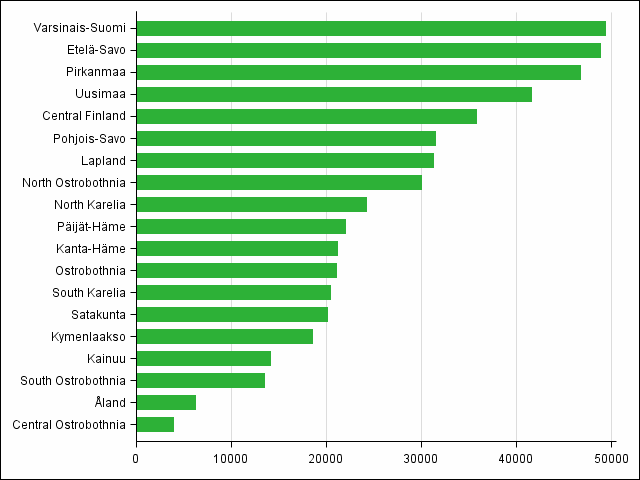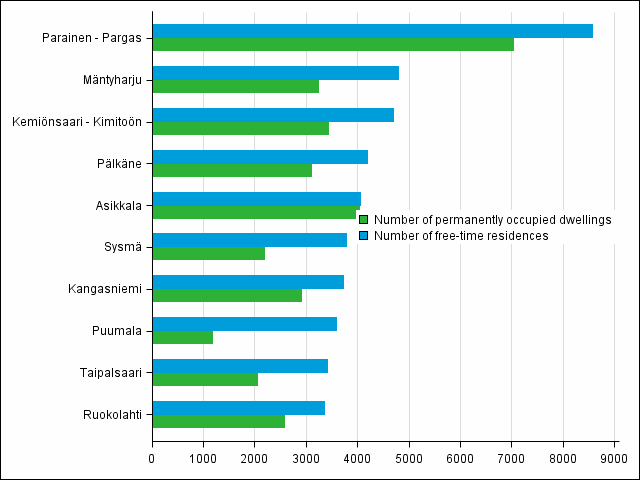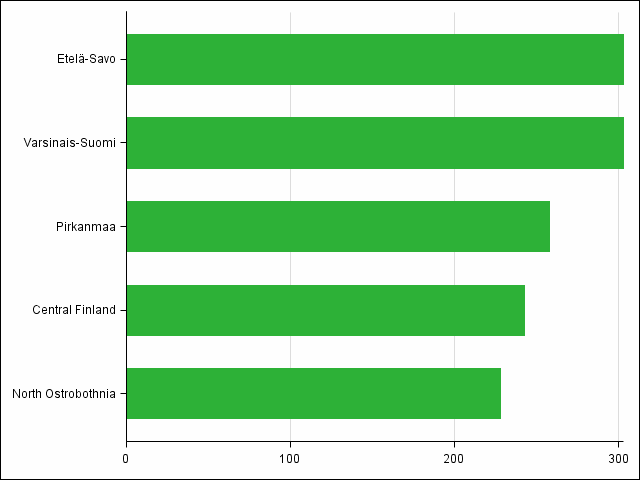Free-time Residences 2014
Varsinais-Suomi was the region with the highest number of free-time residences in 2014
Varsinais-Suomi was the region with the highest number of free-time residences, i.e. 500 400 Etelä-Savo and Pirkanmaa also had more than 45,000 free-time residences. The numbers of free-time residences were lowest in the regions of Central Ostrobothnia (3,900) and Åland (6,200).
Figure 1. Free-time residences by region 2014

The density of free-time residences in the municipality can also be described by comparing their number with that of permanently occupied dwellings. Then the municipalities richest in free-time residences were places that had a relatively low number of population and a high number of free-time residences. At the end of 2014, altogether 62 municipalities had more free-time residences than permanently occupied dwellings. Such municipalities were Parainen, Mäntyharju, Kemiönsaari and Pälkäne. As the number of permanent residents decreases, the number of free-time residences may become emphasised in ever more municipalities. From 2000 onwards, the number of municipalities with a majority of free-time residences has increased approximately by twenty, when the situation is viewed with the present division of municipalities of 2015
Figure 2. Municipalities with more free-time residences than occupied dwellings in 2014 (municipalities with the highest number of free-time residences)

Stock of free-time residences grew fastest in the 1980s
There were 500 400 free-time residences in Finland at the end of 2014. The number increased by 1 728 from the previous year. The stock of free-time residences does not grow direct due to newbuilding because some free-time residences area converted into permanent dwellings or their active use is discontinued. The number of free-time residences grew fastest in the 1980s. In 1990, there were 368,000 free-time residences, which was 46 per cent more than in 1980. From 1970 to 1980, the increase was 75,600, or 43 per cent.
Figure 3. Number of free-time residences 1970–2014

The pace of construction of free-time residences has been slowing down steadily since the early years of the 1990s. Whereas roughly 8,000 free-time residences were built every year in the early 1990s, in recent years the number has been half of this. Through the 1990s, the stock of free-time residences grew by around 20 per cent. This is clearly by less than in the 1970s and 1980s, when the stock increased by over 40 per cent per decade.
About 3,000 new free-time residences completed per year
Over 4,000 new free-time residential buildings have been completed per year in the 2000s. In the 2010s the number of new free-time residential buildings has decreased under 4,000 per year. For example, 3 244 new free-time residential buildings were completed in 2014 (according to statistics of buildingstock).
During 2014, the highest numbers of new free-time residences were built in Etelä-Savo and Varsinais-Suomi. By municipality, the highest numbers of new free-time residences were built in Kuusamo, Savonlinna, Kouvola, Parainen and Kalajoki: over 50 in the year in each. In absolute numbers, the construction of free-time residences decreased further.Figure 4. Regions with highest numbers of new free-time residences built in 2014

Building of free-time residences liveliest in Lapland, Etelä-Savo and Varsinais-Suomi
In 2014 the building of free-time residences has been liveliest in Etelä-Savo and Lapland. In the 2000s, the highest numbers of free-time residential buildings have been completed in general in Lapland, Etelä-Savo and Varsinais-Suomi where their number has grown by over 400 per year.
Since 1990 the stock of free-time residences has grown most in Etelä-Savo, where it has increased by approximately 14 000 The stock has changed least in Central Ostrobothnia and Åland where the number of free-time residences has increased by over 1,000 since 1990.
Summer residence densest in Kustavi and Kaskinen
Free-time residences are densest in the municipality of Kustavi and Kaskinen with average 15–18 free-time residences per square kilometre of land. In six municipalities there are more than ten free-time residences per square kilometre. In the whole country there are, on the average, 1,7 free-time residences per square kilometre. Varsinais-Suomi, Uusimaa, Päijät-Häme, Kanta-Häme and Åland have more than four free-time residences per square kilometre. In North and Central Ostrobothnia, and Kainuu and Lapland there is average less than one free-time residence per square kilometre. In proportion to the land area, Kauniainen, Savukoski, Utsjoki, and Enontekiö have the lowest number of free-time residences.
Average floor area of free-time residences 48 square metres
There are relatively large size differences between new and old free-time residences. The average floor area of the free-time residences built in 2000-2009 was 64 square metres. The median was 56 square metres. On the other hand, nearly one free-time residence in four had a floor area of 60 square metres or more.
Table 1. Free-time residences by floor area in 2014
| Floor area, m2 | Number of free-time residences | % |
| Free-time residences, total | 500 422 | 100,0 |
| – 19 | 45 871 | 9,2 |
| 20 – 39 | 180 829 | 36,1 |
| 40 – 59 | 134 478 | 26,9 |
| 60 – 79 | 62 771 | 12,5 |
| 80 – 99 | 29 253 | 5,8 |
| 100 – | 28 549 | 5,7 |
| Unknown | 18 671 | 3,7 |
| Average floor space | 48 | , |
| Median floor space | 40 | , |
Almost 804 000 Finns belong to a household-dwelling unit with a free-time residence
Of all free-time residences, 413 000 were owned by private persons, while 88 000 were owned by companies, communities and deceased’s estates, or by foreigners. In all, almost 804 000 persons belonged to a household-dwelling unit which owns a free-time residence. Free-time residences are generally located near the place of permanent residence. 64 of free-time residence owners had a free-time residence in their region of residence. One-third of free-time residence owners had a free-time residence in their municipality of domicile. Summer residents more than double the population of many municipalities.
Average age of a free-time residence owners is 62 years
The average age of owners of new free-time residences completed in 2014 was 54 years. The average age of all free-time residence owners was 62. Of all free-time residence owners, 24 000 or just 7 per cent were aged under 40. Over 40 per cent of all free-time residences were owned by a household-dwelling unit of two adults and only 14 per cent by households with children aged under 18.
Median distance between one's home and free-time residence is 37
The average distance between one's home and free-time residence was 91 kilometres and the median was 37 kilometres. Therefore, one-half of the journeys to free-time residences were at most 37 kilometres. The median for the journey of those living in Uusimaa to their free-time residences was 130 kilometres and the average 166 kilometres. The median for the journey of people living in Uusimaa to their free-time residences was over three times compared with the median for the entire country and the average was nearly double compared with the average for the whole country. The median for the journey of those living elsewhere than in Uusimaa to their free-time residences was 26 kilometres and the average 65 kilometres.
The journey to free-time residences was calculated for free-time residences owned by private persons. A journey to a free-time residence refers to the linear distance between the permanent residence and free-time residence of the free-time residence owner. In 2014, the distance could be calculated for 71 per cent of the whole stock of free-time residences.
Source: Buildings and Free-time Residences, Statistics Finland
Inquiries: Topias Pyykkönen 029 551 2628, Marja Hermiö 029 551 3211, Arja Tiihonen 029 551 3272, asuminen@stat.fi
Director in charge: Harala Riitta
Updated 26.5.2015
Official Statistics of Finland (OSF):
Buildings and free-time residences [e-publication].
ISSN=1798-6796. 2014,
Free-time Residences 2014
. Helsinki: Statistics Finland [referred: 19.4.2025].
Access method: http://stat.fi/til/rakke/2014/rakke_2014_2015-05-28_kat_001_en.html

